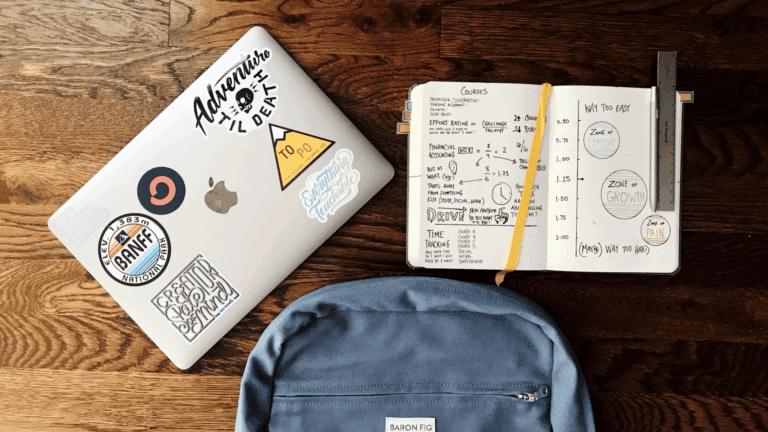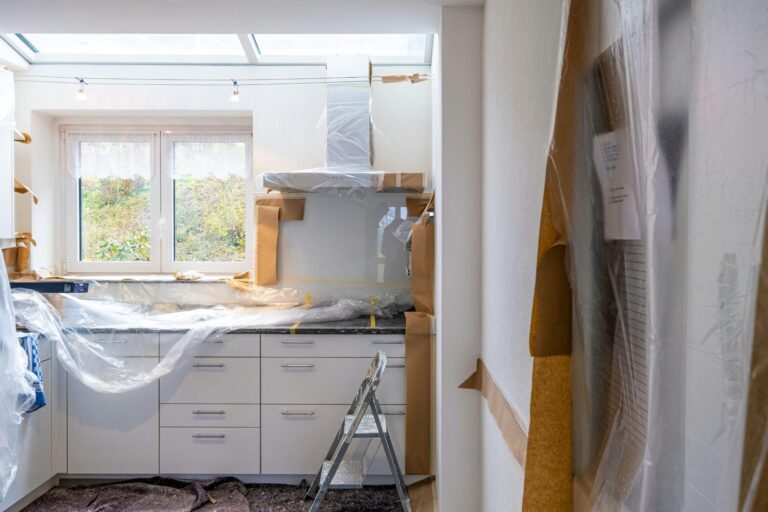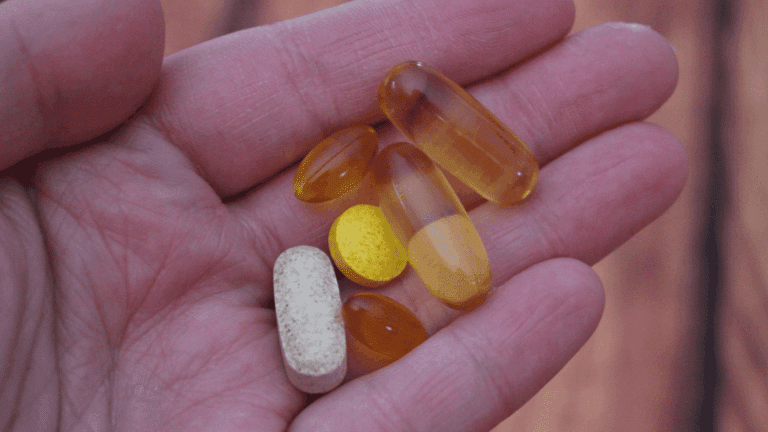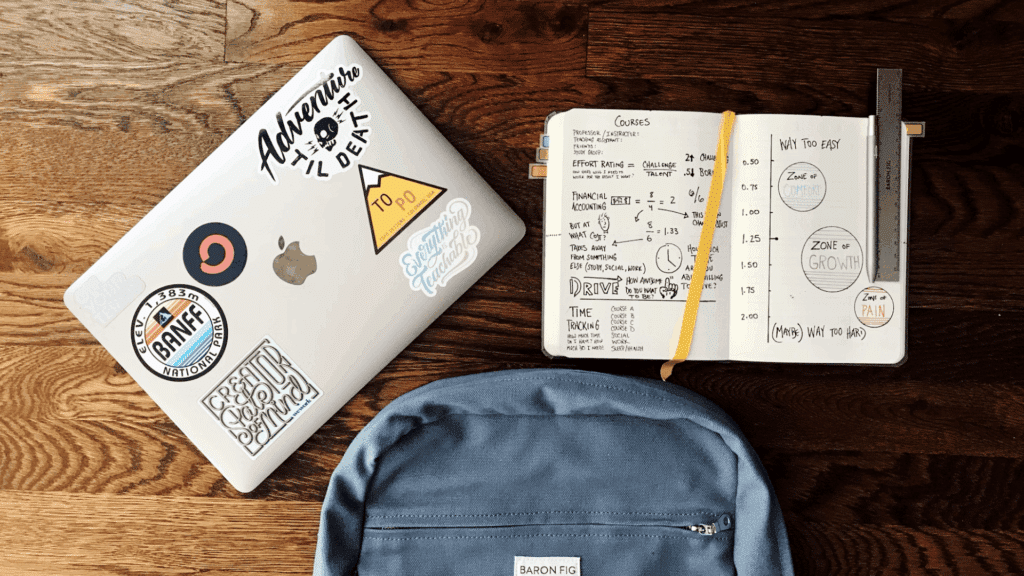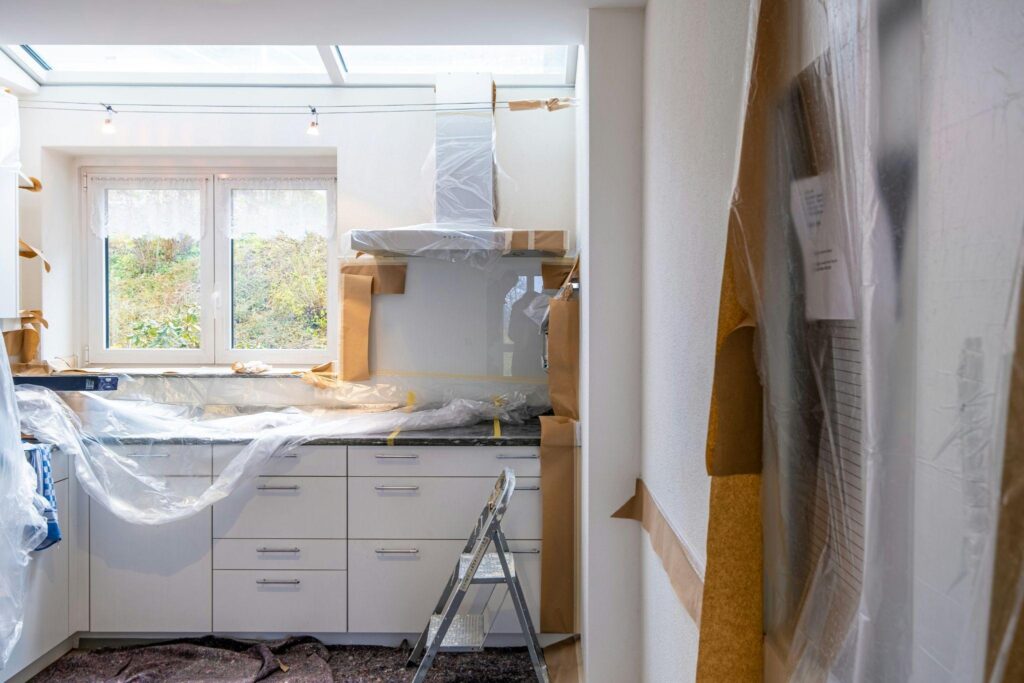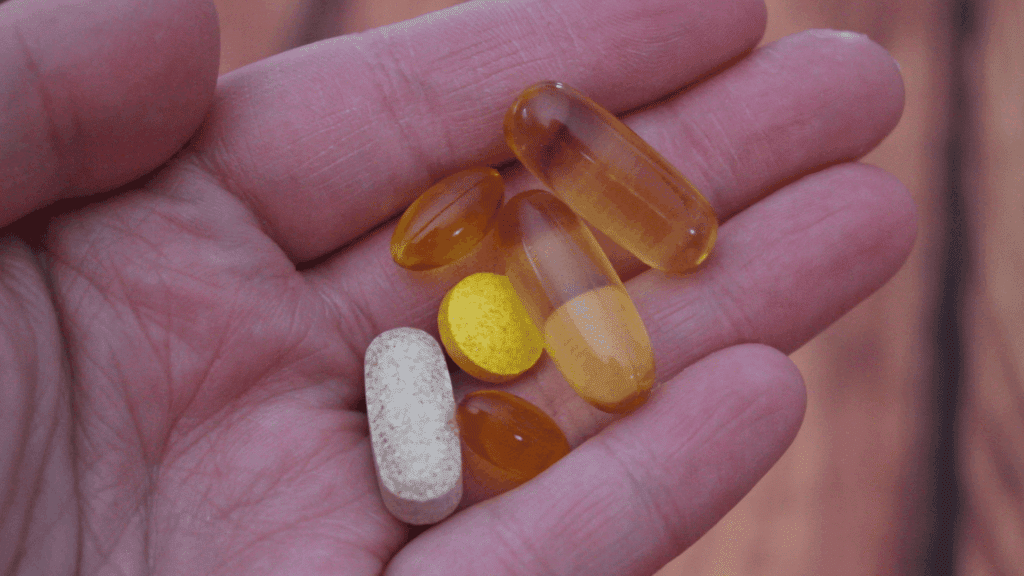Looking for fresh ways to keep your little ones engaged while they learn?
Parents and teachers often struggle with finding activities that hold children’s attention. Traditional learning methods can feel boring. Kids lose interest quickly.
Sensory tables offer the perfect solution. These simple setups turn learning into a playful experience.
Children can touch, pour, and scoop while developing important skills. You likely have most of the materials at home already.
Let’s set up some fun sensory table ideas that your kids will love to use.
Nature-Inspired Sensory Table Ideas
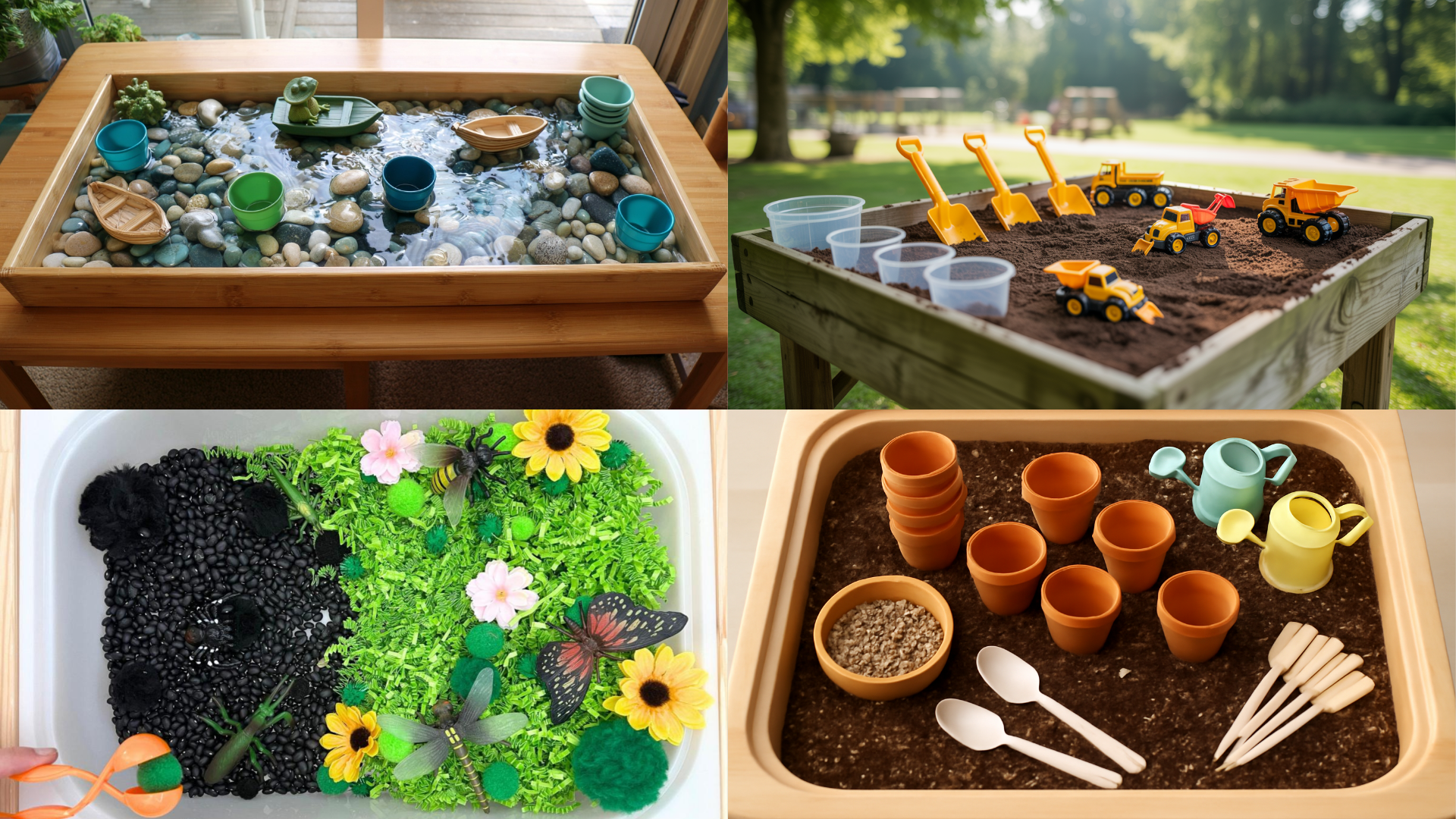
Nature brings out children’s natural curiosity. These outdoor-themed activities help kids connect with the environment while learning.
Simple materials found in your backyard or local park can create rich sensory experiences that support development.
1. Pinecone and Leaf Sorting
This sorting game develops classification skills and teaches children about different textures, shapes, and sizes found in nature. Kids learn to group items by similar characteristics.
Materials required: Pinecones, dry leaves, seed pods, small containers or sorting trays, and magnifying glasses for closer observation.
How kids can perform: Children pick up each natural item, feel its texture, and sort them into different groups based on size, color, or type they choose.
2. Dirt Dig and Dump
This hands-on digging activity develops fine motor skills, enhances hand-eye coordination, and introduces basic concepts about soil and the earth. Children learn cause and effect through digging.
Materials required: Clean potting soil, mini shovels, small diggers, toy trucks, dump trucks, and small containers for loading and unloading dirt.
How kids can perform: Kids use shovels to scoop dirt into truck beds, drive trucks around the table, and dump loads in different spots for construction play.
3. Water and Pebble River
This is one of the sensory table ideas that teaches concepts about flow, floating, and sinking. Children learn about water movement and develop hand coordination through pouring and scooping activities.
Materials required: Shallow water, smooth pebbles, tiny boats, plastic frogs, small cups, and funnels for pouring water over the pebbles.
How kids can perform: Children create rivers by pouring water over pebbles, float boats downstream, and watch how water moves around different obstacles in their path.
4. Garden Planting Station
This is one of the sensory table ideas that introduces plant life cycles, responsibility, and care for living things. Children learn about growth, seeds, and what plants need to survive.
Materials required: Potting mix, flower seeds, small pots, mini watering cans, plastic spoons for scooping, and plant markers for labeling their work.
How kids can perform: Kids scoop soil into pots, place seeds inside, cover with more dirt, and pretend to water their plants while learning about gardening.
5. Mini Bug Safari
This is one of the sensory table ideas that develops observation skills, teaches about different insects, and encourages scientific thinking. Children learn to examine details and ask questions about nature.
Materials required: Plastic bugs and insects, magnifying glasses, moss or mulch, tweezers, small containers, and field guides or bug identification cards.
How kids can perform: Children search through moss to find hidden bugs, use magnifying glasses to examine them closely, and sort insects by different characteristics.
6. Rainstorm Play
This weather-themed activity teaches about weather patterns, cloud formation, and rain cycles. Children learn about cause and effect through simulated weather conditions.
Materials required: Cotton balls for clouds, blue beads or rice for rain, plastic trees, small houses, and spray bottles for creating rain effects.
How kids can perform: Kids arrange cotton clouds above trees and houses, shake blue beads to make rain sounds, and create different weather scenarios.
7. Windy Day Feathers
This wind simulation teaches about air movement, cause and effect, and physics concepts like force and motion. Children learn how wind affects different objects.
Materials required: Various feathers, mini fans or hair dryers, straws for blowing, cardboard houses, lightweight paper pieces, and small windmills.
How kids can perform: Children blow through straws or use fans to move feathers around the table, watching how different objects react to wind.
8. Ocean Animal Rescue
This rescue activity develops problem-solving skills, teaches about ocean animals, and encourages helpful behavior. Children learn about marine life and habitats.
Materials required: Blue gelatin or water beads, small sea animals, warm water, spoons, small nets, and containers for rescued animals.
How kids can perform: Kids use warm water and tools to melt gelatin or move beads, freeing trapped sea animals and placing them in safe containers.
9. Sand and Shell Treasure Hunt
This treasure hunt develops search skills, teaches about ocean life, and builds persistence. Children learn about shells, ocean treasures, and the importance of careful observation.
Materials required: Clean sand, various shells, small treasures like coins or gems, sifters, brushes, magnifying glasses, and small collection containers.
How kids can perform: Children sift through sand using tools to find hidden treasures and shells, brushing them clean and examining their finds closely.
10. Frozen Nature Blocks
This melting activity teaches about temperature changes, states of matter, and seasonal differences. Children learn about ice, melting, and how heat affects frozen objects.
Materials required: Ice cube trays, leaves, small berries, twigs, warm water, droppers, small containers, and towels for cleanup.
How kids can perform: Kids pour warm water over frozen blocks, watch ice melt slowly, and free the natural items trapped inside the ice.
Food & Kitchen Sensory Table Ideas
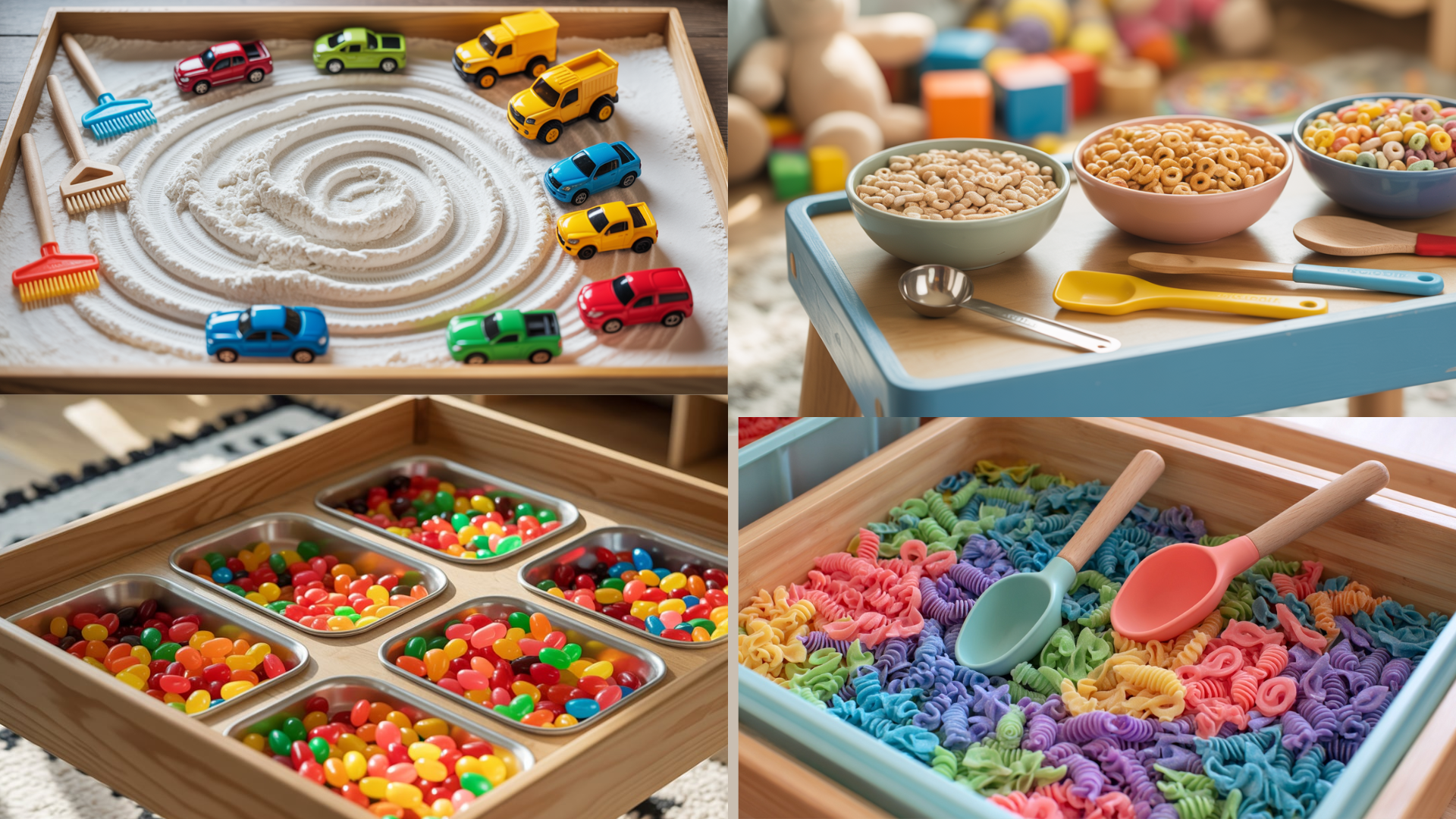
Kitchen materials create safe, familiar sensory experiences for children. These food-based activities teach measurement, textures, and cooking concepts.
Most materials come from your pantry, making setup simple and budget-friendly for parents and teachers.
11. Dry Pasta Bin
This is one of the sensory table ideas that develops sorting skills, teaches shapes and sizes, and builds fine motor control. Children learn about different textures and practice counting skills.
Materials required: Various dry pasta shapes like penne, bow ties, and shells, measuring cups, scoops, small containers, and hidden toy figures.
How kids can perform: Children scoop pasta between containers, sort it by shape or size, and use their hands to search through the pasta to find hidden toys.
12. Cereal Crunch Fun
This crunchy activity teaches about textures, sounds, and pretend cooking skills. Children learn measurement concepts and develop hand coordination through pouring and scooping.
Materials required: Puffed rice cereal or Cheerios, measuring spoons, small bowls, cups, pretend cooking utensils, and aprons for dress-up cooking play.
How kids can perform: Kids scoop cereal into bowls, pretend to cook meals, listen to crunching sounds, and practice pouring between different-sized containers.
13. Cooked Spaghetti Worms
This slimy texture play teaches about different states of matter and builds tolerance for unusual textures. Children learn about the differences between wet and dry materials.
Materials required: Cooked spaghetti noodles, food coloring, tongs, small bowls, plastic forks, and a washable tablecloth for easy cleanup after messy play.
How kids can perform: Children use tongs to pick up slippery noodles, transfer them between bowls, and find out the unusual texture with their fingers.
14. Fruit-Scented Water Play
This aromatic water play engages multiple senses and teaches about natural scents. Children learn about fruits and develop sensory awareness through smell.
Materials required: water, lemon slices, orange peels, fresh mint leaves, small cups, strainers, and towels for splashing and cleanup after water play.
How kids can perform: Kids pour scented water between cups, smell different fruit aromas, and strain out fruit pieces while enjoying the fresh scents.
15. Rice Rattle Station
This music-making activity teaches about sound, rhythm, and cause and effect. Children learn about different volumes and create their own musical instruments.
Materials required: dry rice, small plastic containers with lids, tape, stickers for decoration, funnels, and measuring cups for filling the containers.
How kids can perform: Children scoop rice into containers, tape lids securely, shake to make music, and decorate their homemade instruments with colorful stickers.
16. Flour and Toy Tracks
This tracking activity teaches about patterns, cause and effect, and vehicles. Children learn about different textures and develop creativity through track-making.
Materials required: White flour, toy cars and trucks, small rakes, brushes for smoothing, and a tray with raised edges to contain the mess.
How kids can perform: Kids drive toy vehicles through flour, watch tire tracks appear, smooth flour with brushes, and create different patterns and roads.
17. Pretend Soup Bar
This is one of the sensory table ideas that teaches about measurements, colors, and kitchen skills. Children learn about cooking processes and develop imagination through pretend play.
Materials required: Colored water, plastic vegetables, ladles, soup bowls, measuring cups, aprons, and chef hats for realistic cooking role-play experiences.
How kids can perform: Children ladle colored water into bowls, add plastic vegetables, stir their soup creations, and serve meals to stuffed animals.
18. Pudding Paint Fun
This edible art teaches about textures, colors, and creativity. Children learn about smooth textures and develop artistic expression through safe finger painting.
Materials required: Chocolate or vanilla pudding, washable tablecloth, paper plates, wet wipes, aprons, and cameras to capture their edible artwork creations.
How kids can perform: Kids dip fingers in pudding, paint directly on the table surface, mix colors together, and create edible masterpieces they can taste.
19. Frozen Pea Scoop
This cold transfer activity teaches about temperature, counting, and coordination. Children learn about frozen foods and develop fine motor skills through scooping.
Materials required: Frozen peas, various-sized scoops, funnels, measuring cups, small containers, and towels for any melting water that occurs.
How kids can perform: Children scoop cold peas between containers, count as they transfer, feel the cold temperature, and practice pouring through different funnels.
20. Popcorn Kernel Dig
This treasure hunt teaches about searching, letters, and tools. Children learn persistence and develop hand strength through digging and scooping motions.
Materials required: Unpopped popcorn kernels, measuring cups, hidden alphabet letters or small toys, tweezers, small containers, and sifters for finding treasures.
How kids can perform: Kids dig through kernels to find hidden letters, use tweezers for precise picking, and sort their findings into different containers.
21. Jelly Bean Sort and Scoop
This colorful sorting activity teaches classification skills, colors, and fine motor control. Children learn about grouping objects by attributes and develop precision through careful handling.
Materials required: Large jelly beans or similar colorful candies, tweezers, sorting trays, small bowls, color cards for matching, and magnifying glasses for close examination.
How kids can perform: Children use tweezers to pick up jelly beans, sort them by color or size into different bowls, and match colors to cards.
22. Colored Salt Writing Tray
This writing practice teaches letter formation, pre-writing skills, and creativity. Children learn about textures and develop the hand control needed for future writing tasks.
Materials required: Colored salt, shallow trays, paintbrushes, cotton swabs, letter cards, and small rakes for smoothing salt between writing attempts.
How kids can perform: Kids use fingers or brushes to draw letters in colored salt, copy from letter cards, and smooth salt to start fresh.
23. Foamy Whisking Station
This bubbly activity teaches about mixing, cause and effect, and chemical reactions. Children learn about bubbles and develop arm strength through whisking motions.
Materials required: Water, dish soap, hand whisks, measuring cups, bowls, food coloring, and towels for cleaning up any overflow or spills.
How kids can perform: Children pour soap and water into bowls, whisk vigorously to create foam, add food coloring, and watch bubbles form.
Creative & Themed Sensory Table Ideas
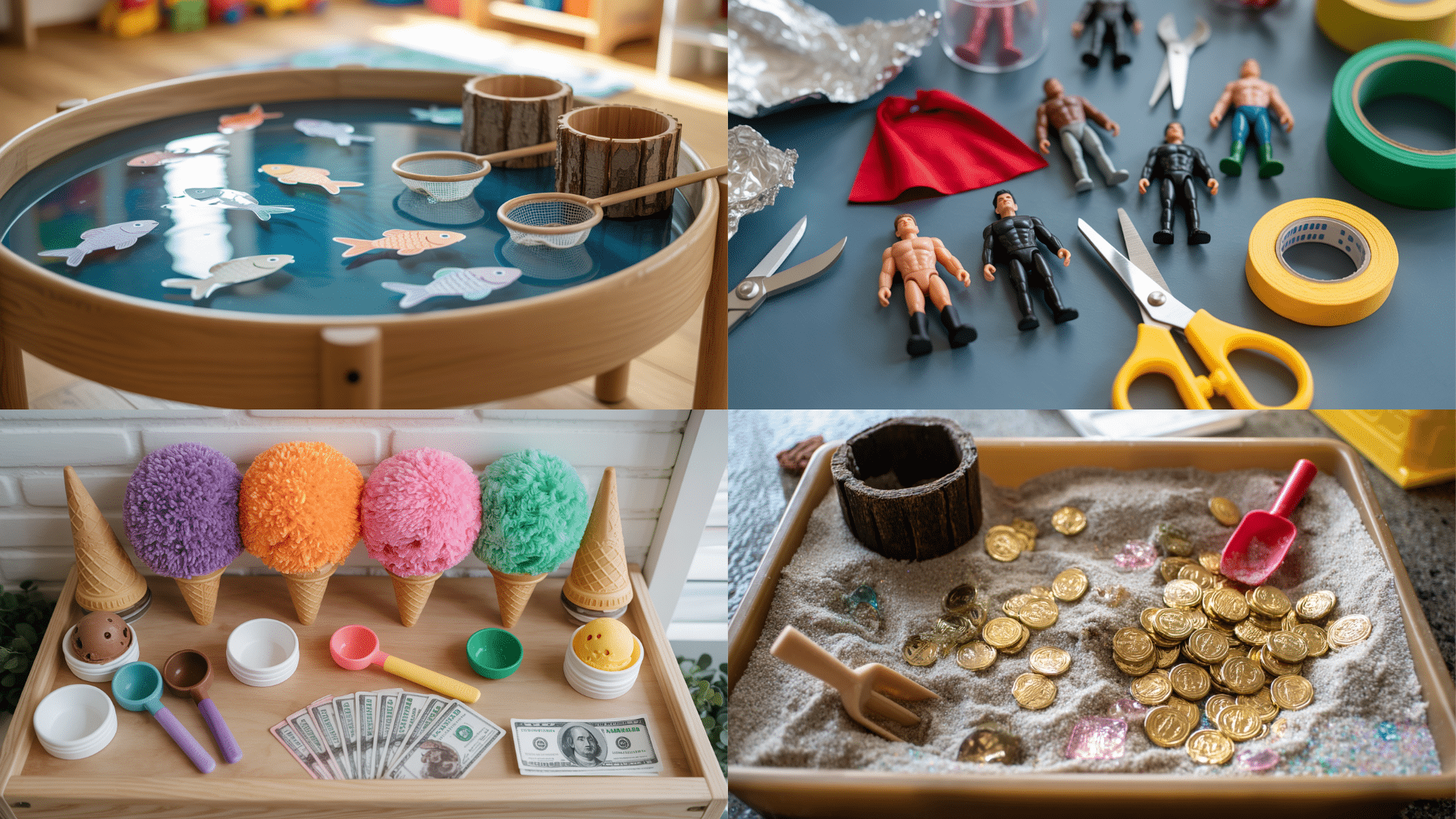
Themed activities improve imagination and storytelling. These creative setups combine learning with fantasy play.
Children can learn through different themes while developing important skills through hands-on experiences that feel like pure fun and play.
24. Construction Site Table
This building play teaches about construction, cause and effect, and spatial reasoning. Children learn about different tools and develop problem-solving skills through building.
Materials required: Kinetic sand, toy bulldozers, excavators, dump trucks, small rocks, traffic cones, and hard hats for realistic construction site role-play.
How kids can perform: Kids operate toy machinery to move sand, build roads and structures, load trucks with rocks, and create their own construction projects.
25. Glow in the Dark Bin
This is one of the sensory table ideas that teaches about light, darkness, and special effects. Children learn about glow-in-the-dark materials and develop visual tracking skills in dim lighting.
Materials required: Glow sticks, black construction paper, glowing stars, glow-in-the-dark beads, small containers, and a dark space for full glowing effects.
How kids can perform: Children arrange glowing materials in dark containers, turn off lights to see effects, and create glowing patterns and designs.
26. Alphabet Hunt in Beads
This letter search teaches alphabet recognition, letter sounds, and visual discrimination. Children learn to identify letters and develop persistence through searching activities.
Materials required: Foam alphabet letters, large dry beads, letter matching cards, tweezers, small containers, and alphabet charts for reference during play.
How kids can perform: Kids search through beads to find specific letters, match found letters to cards, and spell simple words with findings.
27. Arctic Ice Play
This cold-weather play teaches about polar animals, temperature, and habitats. Children learn about different climates and develop imaginative play skills through arctic scenes.
Materials required: Blue-tinted water, polar animal figures, ice cubes, small icebergs made from frozen water, and white fabric for snow effects.
How kids can perform: Children create arctic scenes with animals, float ice pieces in water, and tell stories about polar animals.
28. Magnetic Fishing Game
This is one of the sensory table ideas that teaches about magnets, hand-eye coordination, and patience. Children learn about magnetic attraction and develop focus through catching games.
Materials required: Paper fish with paper clips attached, magnetic wands, blue water or fabric, small nets, and containers for caught fish.
How kids can perform: Kids use magnetic wands to catch paper fish, count their catches, and practice aim and coordination through fishing motions.
29. Moon Dust Dig
This activity teaches about textures, astronomy, and imaginative play. Children learn about space while developing curiosity about planets and astronauts.
Materials required: Flour mixed with baby oil, space toys like astronauts and rockets, moon rocks (painted stones), and space helmets for role-play.
How kids can perform: Children dig through moon dust to find space objects, pretend to be astronauts, and create lunar landscapes.
30. Pirate Treasure Bin
This play teaches about searching, counting, and storytelling. Children learn persistence and develop mathematical skills through treasure counting and sorting activities.
Materials required: Sand, pretend gold coins, colorful beads, small treasure chests, pirate hats, maps, and magnifying glasses for treasure hunting.
How kids can perform: Kids search sand for buried treasures, count gold coins, fill treasure chests, and create pirate stories.
31. Rainbow Water Pouring
This color mixing teaches about primary and secondary colors, measuring, and scientific observation. Children learn about color theory through hands-on experimentation.
Materials required: Colored water in different bottles, clear measuring cups, funnels, droppers, color mixing charts, and towels for spill cleanup.
How kids can perform: Children pour different colored waters together, observe new colors forming, and experiment with different color combinations and measurements.
32. Superhero Rescue Station
This rescue play teaches problem-solving, helping others, and fine motor skills. Children learn about heroes and develop empathy through rescue scenarios.
Materials required: Small action figures, tape, aluminum foil, toy tools for cutting, capes, and containers for rescued figures.
How kids can perform: Kids free trapped figures using tools, create rescue scenarios, wear capes for role-play, and tell heroic rescue stories.
33. Button Sorting Challenge
This sorting activity teaches classification, counting, and pattern recognition. Children learn about attributes and develop mathematical thinking through organized sorting tasks.
Materials required: Mixed buttons in different sizes and colors, sorting trays, tweezers, magnifying glasses, and pattern cards for matching button arrangements.
How kids can perform: Children sort buttons by color, size, or number of holes, create patterns, and count groups of similar buttons.
34. Pom-Pom Ice Cream Shop
This pretend play teaches about colors, counting, and customer service. Children learn about business interactions and develop social skills through role-playing at an ice cream shop.
Materials required: Colored pom-poms as scoops, ice cream cones, small bowls, ice cream scoops, play money, and menus for realistic shop play.
How kids can perform: Kids scoop pom-poms into cones, take pretend orders, count scoops, and serve ice cream to customers and stuffed animals.
35. Weather Forecast Table
This weather play teaches about different weather conditions, seasons, and prediction skills. Children learn about meteorology and develop observation skills through weather reporting.
Materials required: Cotton balls for clouds, paper suns, plastic raindrops, weather cards, toy microphone, and weather map for forecasting practice.
How kids can perform: Children arrange weather elements, practice weather reporting with a microphone, match weather cards to conditions, and predict tomorrow’s weather.
Safety Tips for Sensory Table Activities
Keep children safe while they learn. These simple safety guidelines help prevent accidents during sensory play. Always supervise activities and prepare materials carefully for worry-free fun.
- Always supervise young children during sensory play activities, especially those involving small objects that could pose choking hazards for toddlers.
- Check all materials before use to ensure they are clean, non-toxic, and age-appropriate for the children participating in the activity.
- Keep towels and cleaning supplies nearby for quick cleanup of spills, which can create slippery surfaces and potential falling hazards.
- Set clear boundaries about what materials can be tasted or put in mouths, especially with non-food items like beads or craft supplies.
- Wash hands thoroughly before and after each sensory activity to prevent the spread of germs and maintain good hygiene practices.
Wrapping Up
Sensory tables create wonderful learning opportunities for young children. These hands-on activities help kids develop essential skills while having fun.
Setting up these activities doesn’t require expensive materials or complicated planning.
Most items come from your kitchen or craft supplies.
These sensory experiences support brain development in ways that worksheets can’t match. They build confidence as they pour, sort, and create.
Start simple with one or two materials. Watch how your child responds and build from there. Share your favorite sensory table ideas in the comments below.




